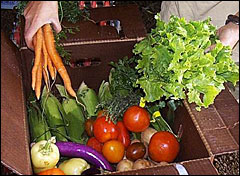Umbra,
Please illuminate CSAs for us, how they work, and how your readers can join one. Thanks! (And by the way, that photo of a peach in your recent column is an apricot.)
Bobbe
Santa Fe, N.M.
Dearest Bobbe,
Alas for stone-fruit misidentification. Hopefully corrected by the time this question hits the screen, but still. A fruit ignorance that community-supported agriculture might solve, if one lived where apricots and peaches grew.
CSA is a way to get the freshest food, grown right near where you live or work, and to support small-scale farmers. In its traditional forms, CSA is a seasonal marriage in which eaters join with growers in the risks and benefits of farming.
There are a variety of ways to structure a CSA farm. The basics are: a farmer advertises for consumers to purchase a share of the season’s harvest and become members. Members pay a lump sum at the start of the season for weekly boxes of mixed produce, which they pick up on the farm or at a drop spot. The farmer benefits by having operating capital to start the season, the members benefit from getting the freshest possible produce, usually picked the same day. The box is roughly the same size per week, often enough for a family of four, or two vegetarian adults, and a season might cost $300 to $700. There are both summer and winter CSAs.
Often members participate in non-financial ways as well, perhaps by working on the farm for part of their membership (this is how one might learn to identify an apricot in situ), or harvesting their own strawberries, or picking up all the shares at the farm and delivering them to an in-town drop spot. Members share in bumper crops and in crop failure (sickness and health), visit the farm for parties, and puzzle over unusual vegetables. Permutations include CSA for meat, eggs, flowers, and other crops; winter memberships; eaters who band together and seek out a farmer instead of vice versa; and sliding-scale memberships. Read an excellent longer, detailed description of the history and social implications at the National Sustainable Agriculture Information Service site.
Sometimes CSA is conflated with produce delivery services, but its cooperative aspects distinguish it from a simple goods-for-pay system. The point is to make a commitment to a local farm and a difference within the larger economic and social trends. It is community-supported agriculture, and there are many amazing stories about what a community will do to support a farmer, such as create a nonprofit organization and buy the farmland to save it from development so “their” farmer can keep on farming. Oh, it brings tears to my eyes.
I think CSA works for folks who cook at home, like vegetables, aren’t picky eaters, and get jazzed about involvement in keeping small farms afloat. If you think that is you, dearest reader, by all means look into it. You can look now, especially if fall and winter vegetables exist in your area, or next spring — we’ll remind you.
If you regularly go to a farmers’ market, ask there which farms also do a CSA, and pick up their brochures. If you’re very lucky, an organization in your area compiles a guide. Failing that, try the Robyn Van En Center, Local Harvest, New Farm, or the Eat Well Guide. Try them all and marvel at the hidden world around you.
Supportively,
Umbra



